عادةً ما يبدأ إنشاء المحتوى ببساطة: أنت أو شركتك لديك جمهور، وجمهورك لديه أسئلة، وتريد أن تجيب على هذه الأسئلة.
ربما تبدأ بمدونة أو منشور على وسائل التواصل الاجتماعي أو صفحة مقصودة. ثم آخر، ثم آخر، ثم آخر، ثم آخر. وقبل أن تعرف ذلك، يكون لديك الكثير من المحتوى.
_ولكن هل نظمته؟ وهل نظامك التنظيمي قابل للتطوير؟
إذا كانت إجابتك على أي من هذين السؤالين في مكان ما بين "ميه" و"لا"، فلا تقلق! فأنت لست وحدك! ففي نهاية المطاف، من الصعب توقع الاحتياجات قبل ظهورها، خاصةً في ممارسة سريعة الوتيرة ومتطورة باستمرار مثل التسويق بالمحتوى.
في الواقع، فإن كليك أب للتسويق والفرق الإبداعية مع الآثار الجانبية للنمو السريع في المحتوى وأعضاء الفريق والعمليات وكل شيء بينهما. لذلك بطبيعة الحال، استخدمنا ClickUp لإنشاء نظام أكثر تنظيماً. ونريد مشاركتها معك!
ما هي قاعدة بيانات المحتوى؟
تصف قاعدة بيانات المحتوى نظامًا يقوم من خلاله شخص أو فريق بدمج المحتوى وسياقه (فكر في تاريخ الإطلاق والحالة والتحليلات) بطريقة موحدة. يتم ذلك لتسهيل إنشاء الحملات القائمة على المحتوى والحفاظ عليها.
تحتفظ معظم الفرق الكبيرة بقاعدة بيانات لكل نوع من أنواع المحتوى الذي يحتاجون إلى تتبعه - الصفحات الرئيسية والمدونات والإعلانات, منشورات وسائل التواصل الاجتماعي -ولكن قد تتمكن الفرق الصغيرة أو الأفراد من الاحتفاظ بكل المحتوى الخاص بهم في قاعدة بيانات واحدة، وتصنيف المحتوى حسب النوع.
في حين أن المعلومات والقوالب المجانية في هذه المدونة تهدف إلى أن تكون بمثابة إرشادات عامة لمساعدتك في بناء قاعدة البيانات الخاصة بك والحفاظ عليها، سيكون هناك دائمًا بعض التجارب والأخطاء أثناء تحديد المكونات التي تحتاجها لتتبع جميع الأشياء الخاصة بك في مكان واحد.
كلمة سريعة عن أنواع قواعد البيانات
من الفروق التي ستسمعها غالبًا عند مناقشة قواعد البيانات هي قواعد البيانات العلائقية مقابل قواعد البيانات غير العلائقية .
ببساطة، تقوم قاعدة البيانات العلائقية بتخزين المعلومات في جداول وتربط المعلومات المجدولة ذات الصلة. وتسمى هذه الروابط بين نقاط البيانات المختلفة في جداول مختلفة القواعد. يعثر محللو البيانات على المعلومات في قاعدة البيانات العلائقية من خلال البحث عن المعلومات عبر لغة خاصة بالمجال مثل SQL.
من ناحية أخرى، قواعد البيانات غير العلائقية ليست بالضرورة منظمة في جداول. فهي مصممة لنوع المحتوى الذي تحتفظ به، وقد تتكون قاعدة البيانات غير العلائقية من طرق متعددة لعرض المعلومات وتسميتها والبحث عنها.
نظرًا لأن ClickUp يسمح لك بإنشاء قواعد بيانات علائقية غير مشفرة لعملك، فإن قاعدة بيانات المحتوى النهائية الخاصة بك ستشبه إلى حد كبير قاعدة البيانات العلائقية التقليدية: سيتم توحيد التسميات والفئات، وسيتم عرض المعلومات في جداول. ومع ذلك، لن يتطلب أي شيء في هذه المدونة أي معرفة بلغة SQL أو أي لغة برمجة أخرى.
مع هذا التنويه الموجز بعيدًا عن الطريق، لنبدأ!
من يستخدم قواعد بيانات المحتوى؟
قبل أن تقضي ساعات في التخطيط والتنظيم وبناء قاعدة البيانات، يجدر بك التأكد من أنك وفريقك ستستفيدون منها بالفعل.
قد تتساءل: "ما نوع الفرق التي تستخدم قواعد بيانات المحتوى بالفعل؟
الجواب البسيط هو إلى حد كبير أي شخص أو أي فريق لديه كميات كبيرة من المحتوى الذي يحتاج إلى تنظيمه وتتبعه وتحديثه - مع التركيز على جزئي التتبع و التحديث. لن تساعدك قاعدة البيانات الجيدة في العثور على المحتوى فحسب، بل ستسمح لك أيضًا بإضافة مقاييس وحالات ومعلومات نوعية إلى هذا المحتوى حتى تتمكن من تحديد:
- ما الذي يحتاج إلى تحديث
- ما الذي يحقق أداءً جيدًا
- لماذا قد يكون أداء أجزاء معينة من المحتوى أفضل من غيرها
- أين توجد فرص لمحتوى جديد
- كيفية أداء المحتوى على مدى فترة طويلة من الزمن
لذلك إذا وجدت نفسك أنت أو فريقك تسأل أيًا من هذه الأسئلة، فإن الأمر يستحق وقتك على الأقل للتفكير في قاعدة بيانات المحتوى.
تعتبر قواعد بيانات المحتوى مفيدة لتنظيم الأصول لأي نوع من الفرق، ولكنها عادةً ما تتعقب المعلومات الخاصة بـ
- فرق التسويق والفرق الإبداعية
- الوكالات
- فرق الخدمات المهنية
- الوكالات
- المتخصصون في التعليم في حين أن هذا المنشور سيشرح قواعد البيانات في سياق فريق تسويق المحتوى، فإن المعلومات تنطبق على أي شخص يحاول إدارة كميات كبيرة من المحتوى.
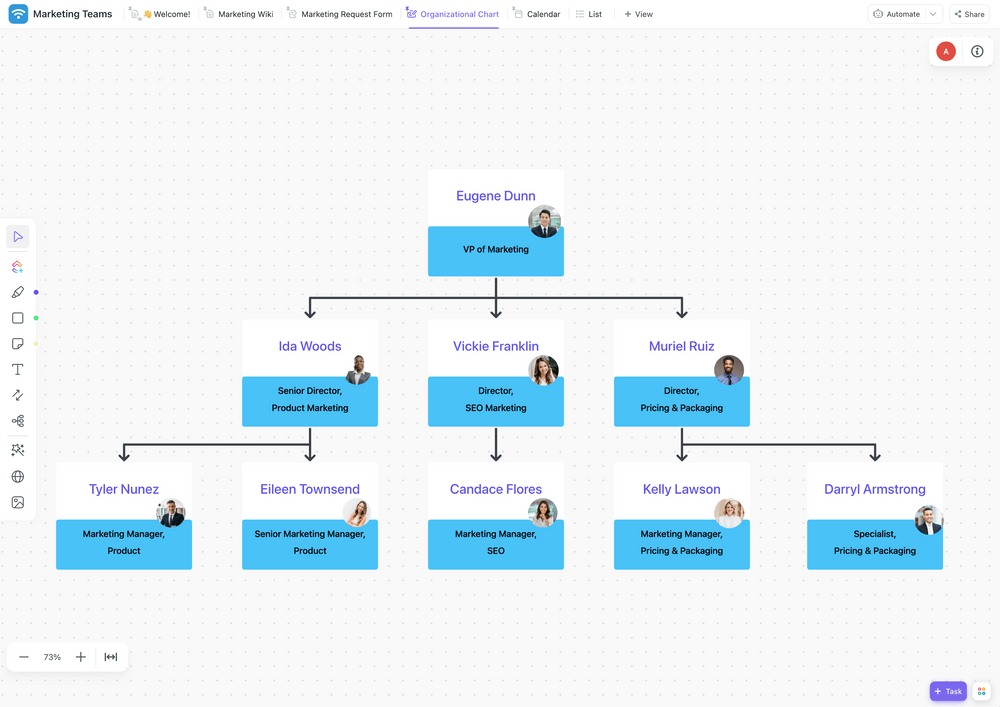
نظّم جميع أعضاء فريق التسويق لديك من خلال سير العمل التعاوني ومشاركة المستندات
مع ازدياد توزع الفرق وتعددها، يصبح من الصعب بشكل متزايد البقاء في صميم العمل لأن أي خلل أو اضطراب في الإجراءات يتضخم. إن نموذج ClickUp لفرق التسويق يوفر حلاً للتعاون بشكل أفضل من خلال دمج جميع مهام التسويق، وتحسين الرؤية عبر قسم التسويق، والسماح بالاستجابة السريعة.
لماذا إنشاء قاعدة بيانات المحتوى؟
سواء كنت فريقًا مكونًا من شخص واحد أو مائة، فمن المحتمل أن تندرج أسباب إنشاء قاعدة بيانات المحتوى في واحدة أو أكثر من الفئات التالية:
- تنظيم الأصول
- تتبع المقاييس الرئيسية
- تنظيم الأصول والتحكم في توزيعها
- ربط الأصول بالأداء
بينما لعب كل عامل من هذه العوامل دورًا في قرار فريق ClickUp Marketing ببناء قواعد بيانات المدونة والصفحات المقصودة، إلا أن أكبر احتياجاتنا كانت قابلية التوسع.
فمع نمو كل فريق بسرعة، كنا بحاجة إلى طريقة لأخذ الكميات الهائلة من المعلومات التي كانت تعيش في أذهان عدد قليل من الأشخاص وإتاحتها لفريق جديد غير معتاد على سنوات من العمليات والبرامج الخاصة بـ ClickUp.
لكن قابلية التوسع هي مجرد واحدة من فوائد قاعدة بيانات المحتوى التي تتم صيانتها بشكل جيد. دعونا نتعمق في المزايا الأخرى:
1. توفر قواعد البيانات وقت فريقك.
الصفقة الرئيسية لـ ClickUp هي توفر لك يومًا واحدًا كل أسبوع ، لذا لنكن واقعيين، "يوفر لك الوقت" كانت دائمًا ما ستكون رقم واحد لدينا. لكن هذا لا يجعلها أقل صحة! بعد كل شيء، إذا لم يتم تجميع المحتوى معًا بطريقة موحدة، فهذا يعني أنه إما
- مجمعة معًا بطريقة غير موحدة (مما يجعل العثور على شيء ما مثل البحث عن إبرة في كومة قش)
- موزعة عبر منصة كاملة أو سلسلة من المنصات (مما يجعل العثور على شيء ما مثل البحث عن إبرة في حقل من أكوام القش)
- مخزنة بعيداً في رأس شخص ما، أو الأسوأ من ذلك، مخزنة على القرص الصلب لجهاز الكمبيوتر الخاص به (وهو ما يشبه على ما أعتقد سؤال المزارع عما إذا كان يتذكر أي كومة قش وضع تلك الإبرة فيها)
من ناحية أخرى، فإن تخزين كل شيء في قاعدة بيانات يشبه تخزين كل إبرتك في درج واحد مكتوب عليه "إبر" حتى لا تضطر إلى البحث في أكوام القش لإنهاء مشروع التطريز الخاص بك.
ببساطة، إذا قضيت وقتاً أقل في البحث عن الأشياء، سيكون لديك وقت أكثر للعمل على بنائها وتحسينها.
عندما يعرف الجميع أين يمكن العثور على شيء ما، فهذا يضمن أيضًا أن فريقك لن يكرر الجهود من خلال إنشاء شيء موجود بالفعل من الصفر لأنهم لم يتمكنوا من العثور عليه. لأننا لنكن صادقين، في مرحلة أو أخرى، قمنا جميعًا في وقت أو آخر بإعادة إنشاء جزء من المحتوى لأنه كان أسهل من البحث عنه.
والأكثر من ذلك، فإن تخزين المحتوى في قاعدة بيانات - خاصةً المستندة إلى السحابة - يجعل الجميع يعرف أين يمكن العثور على أحدث إصدار من شيء ما.
2. قواعد البيانات تجعل قابلية التوسع ممكنة.
إذا تُرك كل شخص تقريبًا لأجهزته الخاصة، سيأتي كل شخص تقريبًا بنظامه التنظيمي الخاص به.
عندما تكون الشخص الوحيد الذي يحتاج إلى استخدامه، فلا بأس بذلك. إذا احتاج شخص أو اثنان آخران إلى تعلم نظامك، حتى لو كان عشوائيًا بعض الشيء، فلا بأس بذلك عادةً.
ولكن عندما ينمو الفريق بحيث يحتاج عشرة ثم عشرون ثم مائة شخص إلى التكيف مع نظام مرتجل وضعه شخص واحد وغالبًا ما يكون لشخص واحد، فأنت تواجه مشكلة.
الفكرة من قاعدة بيانات محتوى جيدة التنظيم هي منع هذه المشكلة قبل أن تنشأ. لذا حتى لو كنت حالياً فريقاً من شخص واحد وقمت بتنظيم كل المحتوى الخاص بك بطريقة تناسبك، فكر فيما إذا كان هذا النظام سيظل يعمل عندما يحتاج عشرات الأشخاص الآخرين إلى استخدامه.
إذا كانت إجابتك هي "ربما" أو "😬" فقد يكون الوقت قد حان لتصبح أكثر تنظيماً واستراتيجية في تتبع المحتوى الخاص بك.
3. تتيح قواعد البيانات إمكانية تحليل المحتوى وتحسينه.
واحدة من أكبر فوائد قاعدة البيانات المنظمة بشكل جيد هي أنها لا تسمح للأشخاص بالعثور على الأشياء فقط (إذا كان الأمر كذلك فستكون مجرد مكتبة محتوى) ولكنها أيضًا تعطي سياق المحتوى. أي أنها تسمح لك بالاطلاع على البيانات الكمية مثل عدد الزيارات والتفاعل والحالة والتاريخ التي يمكن أن تساعدك على تحسين محتوى معين وتحسين تطوير المحتوى بشكل عام.
وعندما يكون لدى الجميع إمكانية الوصول إلى قاعدة البيانات، يمكن للجميع التفكير باستخدام السياق نفسه، مما قد يؤدي إلى ظهور بعض الطرق الجديدة الثاقبة لمقاربة المحتوى.
على سبيل المثال، عند تشغيل تدقيق وسائل التواصل الاجتماعي ، قد يطلع أحد المتخصصين على منشور مدونة ذات حركة مرور عالية ومشاركة عالية في قاعدة بيانات المحتوى ويدرك أنه يتضمن إحصائيات يمكن استخدامها لإنشاء سلسلة من منشورات LinkedIn. قد يطلع مسوق البريد الإلكتروني على نفس المنشور ويدرك أنه يتضمن تفصيلاً للعملية يمكن أن يشكل رسمًا بيانيًا رائعًا لرسالة إخبارية قادمة.
إن مجرد وضع المحتوى في سياقه وإتاحته للجميع يتيح الحصول على رؤى جماعية أكبر ويشجع على التذرية للمحتوى الأفضل أداءً
إن تنظيم وتتبع كل شيء في مكان واحد يسهّل أيضًا على فرق البيانات مقارنة أداء المحتوى حتى يتمكنوا من تقييم ما ينجح وما لا ينجح، وإجراء التغييرات المناسبة على استراتيجيات المحتوى المدفوع أو العضوي.
ما الذي يجب أن تحتويه قاعدة بيانات المحتوى؟
سيختلف تحديد المعلومات التي يجب تضمينها في قاعدة بيانات المحتوى الخاص بك بناءً على نوع المحتوى الذي تتعقبه وسبب تتبعه، ولكن إليك بعض الإرشادات الجيدة التي يجب اتباعها:
1. ابدأ باللبنات الأساسية.
أولاً، يجب عليك تحديد نوع الأصول - صفحات الويب أو منشورات وسائل التواصل الاجتماعي أو المدونات أو كل ما سبق - التي تحتاج إلى تنظيمها وتتبعها. بعد ذلك، يجب أن تقرر كيف ستقوم بتتبع هذه الأصول.
إذا كان من الممكن اعتبار المحتوى الذي تتعقبه مجموعة من العناصر، فإن "كيفية تتبعه" هي حاويات التخزين التي تستخدمها لتنظيم المواد. يجب أن تختار حاوية تخزين يسهل تعبئتها وتتسع لجميع المعلومات الضرورية ويمكن تصنيفها وتحديد مكانها بسهولة فيما بعد.
إذا كنت تستخدم ClickUp لإنشاء قاعدة بيانات، نقترح استخدام المهام لتخزين أجزاء فردية من المحتوى. لكننا سنغطي هذا بمزيد من التفصيل في القسم التالي.
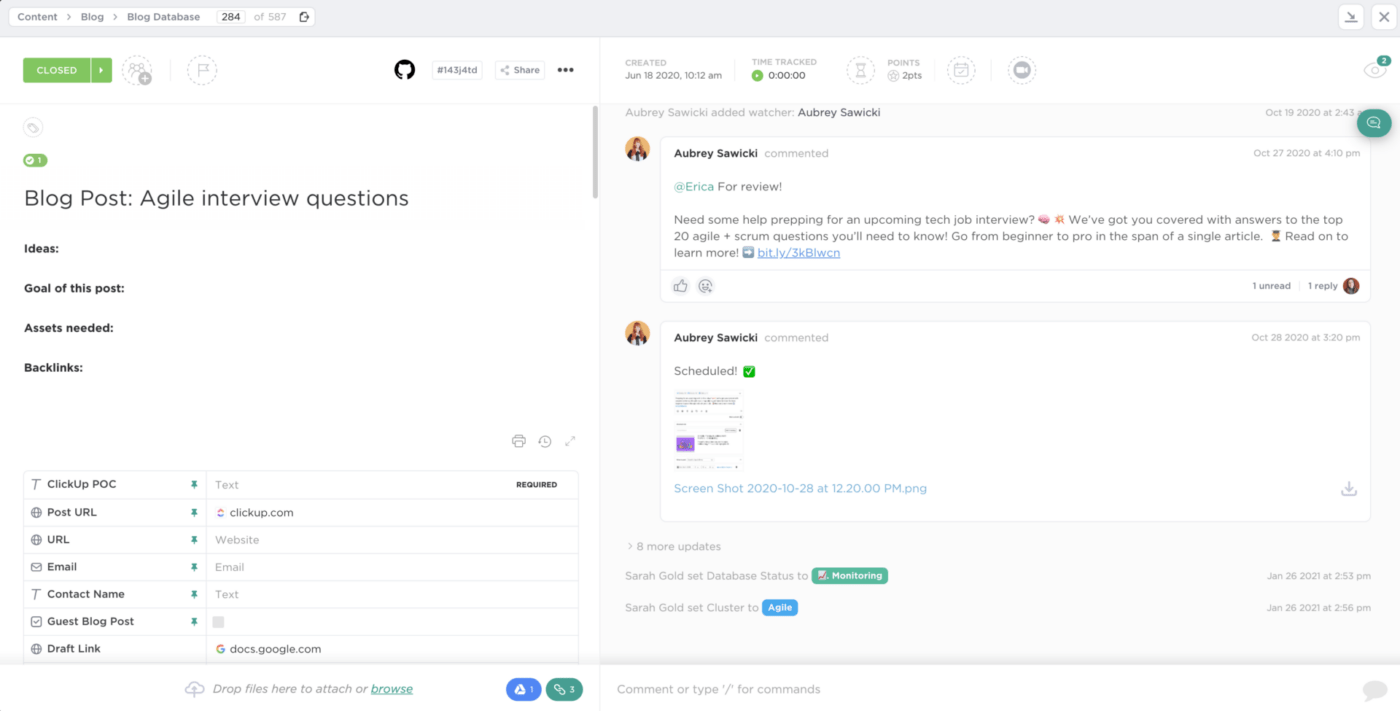
مهمة قاعدة بيانات المدونة في ClickUp
2. قرر كيف ستصنف المحتوى.
بمجرد أن تقرر نوع (أو أنواع) المحتوى الذي تتبعه وكيفية تخزينه، يجب أن تقرر كيفية تصنيفه.
في حالة ClickUp، نحتفظ بقاعدة بيانات منفصلة للمدونات والصفحات المقصودة، ونصنف كل منها حسب الفئة.
يتم تجميع المدونات حسب الموضوع، لذا نقوم بتضمين حقل مخصص بخيارات مثل Agile، CRM، Tools، Work/Life، إلخ.
يتم تجميع الصفحات المقصودة حسب النوع، بحيث يحتوي نفس الحقل المخصص في مهمة الصفحة المقصودة على خيارات مثل ميزة، منافس، فريق، _، إلخ.
عند ابتكار التسميات الخاصة بك، بغض النظر عما إذا كنت قد قررت التصنيف حسب الموضوع أم لا، تذكر أن استخدام التسميات بشكل متسق هو أهم شيء. تأكد من فهمك أنت وفريقك لما تعنيه كل تسمية، وتأكد من اتساق تهجئة التسميات وحروفها الكبيرة.
3. حدد المعلومات الأخرى التي تحتاج إلى تخزينها.
الآن بعد أن قررت ما الذي تقوم بتخزينه في قاعدة بياناتك وكيفية تنظيمه، يمكنك البدء في ملء التفاصيل. في هذه المرحلة، عليك التفكير في بعض الأسئلة الرئيسية:
- أين يقع المحتوى الخاص بي؟
- ما هي "حالة" المحتوى الخاص بي؟ (هل يحتاج إلى تحديث؟ هل هو قيد المراجعة؟)
- من المسؤول عن صيانة هذا المحتوى؟
- كيف يعمل المحتوى الخاص بي؟
ستساعدك الإجابة على هذه الأسئلة في تحديد المعلومات التي تحتاج إلى تضمينها في مهام قاعدة البيانات الخاصة بك. (_ أو، إذا لم تكن تستخدم ClickUp، أي "حاوية" تستخدمها لتخزين المعلومات حول المحتوى.)
سنلقي نظرة على بعض التفاصيل المحددة التي نتتبعها في قاعدة بياناتنا في القسم التالي.
4. حدد العمليات التي ستتم إدارتها داخل قاعدة البيانات الخاصة بك.
لا تكون قاعدة البيانات مفيدة إلا إذا كانت تساعدك أنت وفريقك على دمج المعلومات وتبسيط سير العمل الحالي.
_ففي النهاية، إذا كنت لا تريد أن تفعل أي شيء بالمحتوى الخاص بك، فلماذا تستغرق كل هذا الوقت لإضافته إلى قاعدة بيانات؟
عندما تقرر التفاصيل التي تريد تتبعها، ضع في اعتبارك أيضًا كيف ستساعدك أنت وفريقك في ربط قاعدة البيانات بأي عمليات حالية تتضمن المحتوى.
على سبيل المثال، لنفترض أنك أنشأت قاعدة بيانات لجميع صفحات الويب الخاصة بك وتحتاج إلى شخص ما في فريقك للتحقق من المنشورات كل ستة أشهر من تاريخ نشرها للتأكد من دقة المعلومات. ستحتاج إلى التأكد من أن كل مهمة من مهام صفحات الويب تحتوي على حالة "مطلوب مراجعة" أو "مطلوب تحديث" وتاريخ استحقاق. يمكنك حتى إضافة المراجع كمسند إليه في المهمة للإشارة بوضوح إلى مسؤولياته.

الحالات المخصصة في مهمة ClickUp
سيؤدي ضمان سهولة العثور على المحتوى الخاص بك ودمجه في مهام سير العمل إلى توفير وقت فريقك وتسهيل تدريب أعضاء الفريق الجدد على استخدام قاعدة البيانات وتعلم العمليات الداخلية.
بالإضافة إلى ذلك، سيسمح لك تتبع الحالات والتسميات والمقاييس باستمرار بإعداد الأتمتة للحفاظ على قاعدة البيانات وتسهيل العمليات. المزيد عن الأتمتة بعد قليل .
كيفية إنشاء قاعدة بيانات المحتوى
عندما تقرر إنشاء قاعدة بيانات محتوى لك ولفريقك، تأكد أولاً من أن جميع المشاركين في المشروع يعرفون المشاكل التي ستحلها قاعدة البيانات هذه. يمكنك القيام بذلك باستخدام قائمة بسيطة، مثل القائمة الموضحة أدناه لقاعدة بيانات المدونة:
مشاكل محتوى المدونة:
- مهام ومعلومات المدونة لا تعيش في مكان واحد
- مقاييس المدونة ومؤشرات الأداء الرئيسية يتم تتبعها بشكل غير متسق
- فرق الوسائط الاجتماعية وفرق الوسائط المدفوعة لا تملك رؤية للمدونات المتاحة
من نقاط الألم هذه، قم بإنشاء وصف من جملة أو جملتين لقاعدة البيانات:
"تم تصميم قاعدة بيانات المدونة هذه لتكون بمثابة مرجع مركزي لمدونات ClickUp. يُرجى تجنب إنشاء مهام المدونة في أي مكان آخر في ClickUp، وقم بتخزين جميع معلومات المدونة ذات الصلة في المهمة المقابلة، وقم بتحديث معلومات المهمة عند إجراء أي تعديلات على النسخ أو تحسين محركات البحث."
هذا يعطي أعضاء الفريق الحاليين والجدد بعض السياق حول كيفية استخدام قاعدة البيانات. على سبيل المثال، في المثال أعلاه، نحن نقول في المثال أعلاه أن جميع معلومات المدونة يجب أن تكون موجودة في قاعدة البيانات.
يمكنك أيضًا استخدام نقاط الألم أعلاه للمساعدة في تحديد المعلومات التي يجب تضمينها في قاعدة البيانات الخاصة بك، وكيفية تخزينها وتنظيمها. قم بذلك من خلال تحديد كيف تنوي استخدام قاعدة البيانات لحل كل مشكلة:
- المشكلة: مهام المدونة ومعلوماتها لا تعيش في مكان واحد
- الحلول: _: * أنشئ قائمة بجميع صفحات المدونة النشطة، وتأكد من إضافة كل مدونة كمهمة إلى قاعدة البيانات، إما عن طريق نقل مهام المدونة الحالية أو إنشاء مهام جديدة صافية. احذف أي نسخ مكررة أثناء هذه العملية * إنشاء نظام تسمية وتوسيم واضح ومتسق لمهام المدونة لتسهيل إمكانية البحث * التأكد من تحديث إجراءات التشغيل الموحدة للمدونة لتشمل المعلومات المذكورة أعلاه_
يضمن تكرار هذه العملية لكل نقطة ألم رئيسية أن قاعدة بياناتك تحل المشاكل الصحيحة.
لتصور ما ينتج عن هذه العملية، دعنا نحلل إحدى المهام في قاعدة بيانات مدونة ClickUp:
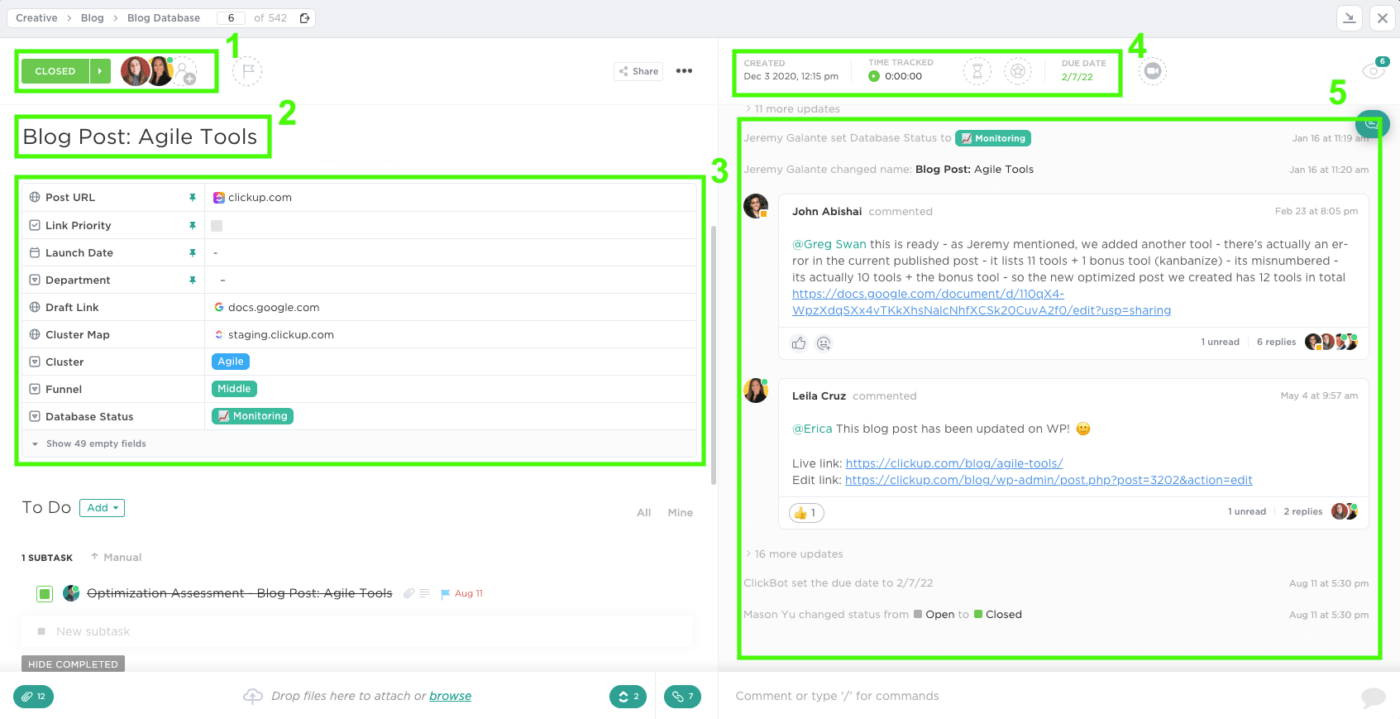
تقسيم مهمة قاعدة بيانات المدونة في ClickUp
- الحالة والمكلفون: يُظهر مكان المدونة في عملية التفكير والإنشاء والمراجعة ومن يعمل (أو كان يعمل مؤخرًا) على المدونة
- اسم المهمة: نظام تسمية متناسق وسهل التذكر لتسهيل التنظيم وإمكانية البحث
- حقول مخصصة: تتبع وتخزين الأجزاء الرئيسية من المعلومات التي تخبرنا بمكان العثور على المحتوى ("عنوان URL للنشر" في الصورة أعلاه) وماذا نفعل به ("حالة قاعدة البيانات"). يجب تنفيذ هذه التفاصيل والتسميات بشكل متسق عبر جميع الأصول، ويجب أن يكون من السهل على أي شخص العثور عليها والرجوع إليها
- معلومات الجدول الزمني: تتبع دائمًا متى تم إنشاء الأصل ومتى يجب تحديثه أو مراجعته (يتم تتبعه في "تاريخ الاستحقاق" في المثال أعلاه). إذا كنت تعمل مع متعاقدين أو موظفين بالساعة، يمكنك أيضًا تتبع الوقت في قاعدة البيانات لحساب الساعات المدفوعة
- سجل التعليقات: شجع فريقك على الاحتفاظ بجميع الاتصالات المتعلقة بجزء من المحتوى في مكان واحد. بهذه الطريقة، إذا تم إدخال صاحب مصلحة جديد في العملية، يمكنه الوصول إلى السياق التاريخي دون إجراء مقابلات مع كل من عمل على المدونة. في مهام ClickUp، تُعد التعليقات طريقة رائعة لضمان وجود جميع الاتصالات في مكان واحد مع إبقاء المحادثات حول كل مدونة منفصلة.
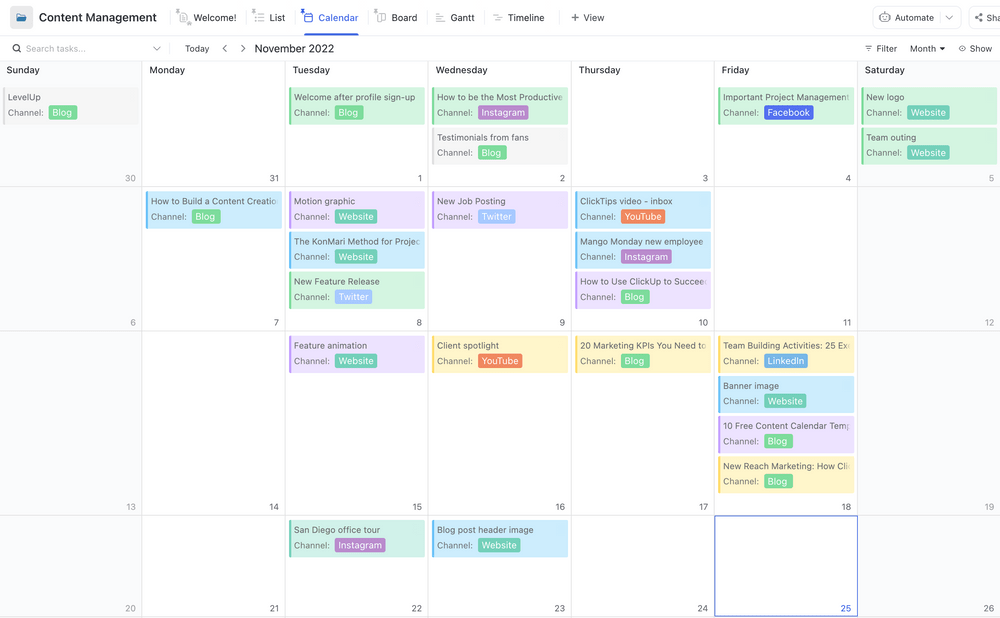
استخدم قالب ClickUp لإدارة المحتوى لعرض التقويمات المخصصة عبر قنوات متعددة
بينما قد تكون قاعدة البيانات الخاصة بك مهيأة بشكل مختلف وتحتوي على معلومات مختلفة عن المثال أعلاه، إلا أن هذا يجب أن يوفر نقطة انطلاق جيدة لك ولفريقك. باستخدام قالب إدارة محتوى ClickUp يمكنك بسهولة تخطيط وتنفيذ التسليم عبر قنوات تسويقية متعددة. كما يوفر أيضًا رؤية واضحة لخطة توزيع المحتوى الخاص بك أيضًا.
اعتبار آخر مهم هو كيف تريد مراجعة كل هذه المعلومات على مستوى عالٍ. على الرغم من أهمية وجود جميع المعلومات الخاصة بجزء من المحتوى مدمجة في مكان واحد، إلا أنه من المهم أيضًا أن تكون قادرًا على فرز أجزاء متعددة من المحتوى وتصفيتها وتجميعها والبحث عنها بسرعة وسهولة. وهنا يأتي دور عرض ClickUp ادخل
بينما يمكنك تصور قاعدة البيانات الخاصة بك بأي عدد من الطرق في ClickUp، سنلقي نظرة فاحصة على اثنين من أكثر طرق العرض "الملائمة لقاعدة البيانات" هنا:
1. عرض القائمة
طريقة عرض القائمة مفيدة للغاية لتجميع المحتوى الخاص بك وتصفيته بسرعة بطرق مختلفة للحصول على رؤى أفضل ولإجراء مقارنات بين أنواع المحتوى. بشكل افتراضي، ستقوم طريقة عرض القائمة بتجميع المعلومات حسب الحالة، لكن خيارات التصفية والفرز الدقيقة في ClickUp تسمح لك بعرض المحتوى بناءً على أي متغير.

خيارات التجميع لطريقة عرض القائمة في ClickUp
كما هو موضح أعلاه، غالبًا ما نقوم بالتجميع حسب فئة المحتوى، ولكن يمكن تجميع قاعدة البيانات بنفس السهولة حسب حالة قاعدة البيانات، والمُعيّن، وتاريخ الاستحقاق، وغير ذلك.
للاستفادة بشكل صحيح من خيارات التجميع والتصفية والفرز العديدة المتاحة في طريقة عرض القائمة (من بين خيارات أخرى)، من الضروري أن تنشئ اصطلاحات تسمية واضحة ومتسقة في قاعدة البيانات الخاصة بك وتحافظ عليها.
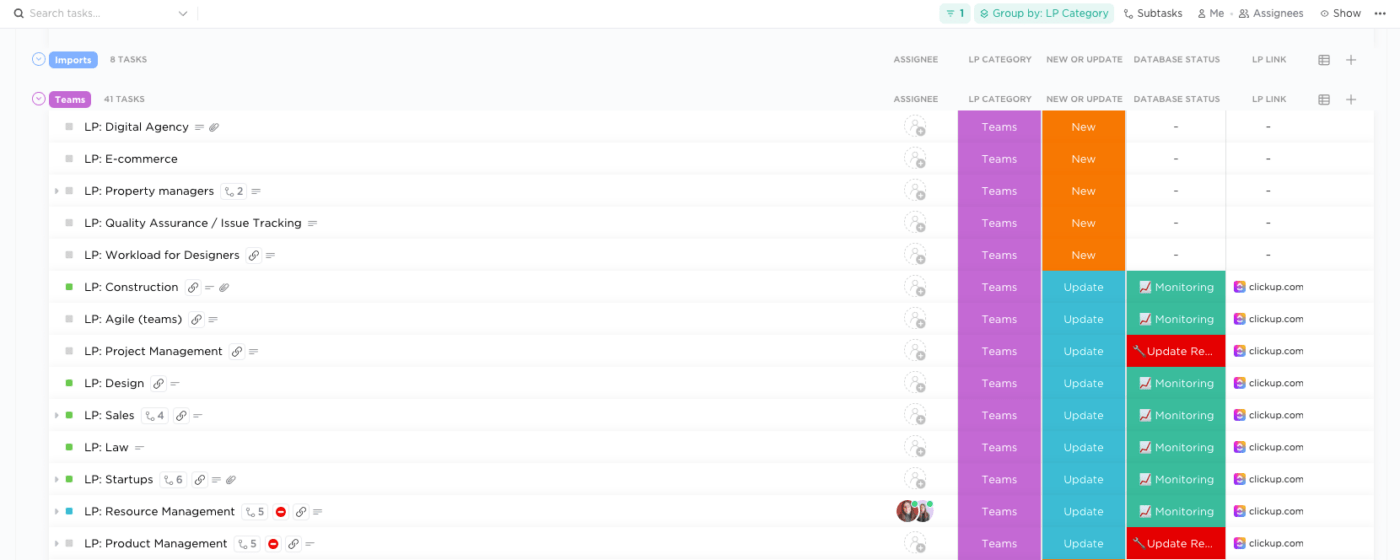
التسمية الموحدة للصفحات المقصودة في عرض قائمة ClickUp
2. عرض الجدول
تمنحك طريقة عرض الجدول عرضًا عالي المستوى لمحتويات قاعدة البيانات. تُعد طريقة العرض هذه مثالية لتخزين ومراجعة تحليلات المحتوى (مثل عدد الزيارات ومعدلات النقرات ومعدلات التحويل) ولرؤية الحالة التي توجد بها العديد من أجزاء المحتوى الفردية بسرعة.
تعد طريقة عرض الجدول مفيدة للغاية أيضًا إذا كنت تنشئ قاعدة بيانات علائقية بدون رمز للمحتوى الخاص بك. لإنجاز ذلك، ما عليك سوى تضمين حقل (حقول) مخصصة تسمح بتضمين الروابط، والتي يمكن الوصول إليها بعد ذلك من طريقة عرض الجدول، مما يسمح للمستخدمين بالانتقال إلى المعلومات ذات الصلة بنقرة واحدة.
وبالمثل، استخدم العلاقة و التبعية ميزات داخل المهام لتنظيم قاعدة بيانات علائقية واضحة بدون تعليمات برمجية.

قاعدة بيانات صفحة الهبوط مرئية في طريقة عرض الجدول في ClickUp
على الرغم من أن هاتين الطريقتين هما أكثر طريقتين يستخدمهما فريق ClickUp لإنشاء محتوى قاعدة البيانات والحفاظ عليها، إلا أنهما ليستا بأي حال من الأحوال الطريقتين الوحيدتين المفيدتين للقيام بذلك.
قد تستفيد قاعدة البيانات الأصغر حجمًا والموجهة بشكل كبير نحو سير العمل من طريقة عرض لوحة كانبان في ClickUp .
يمكن أن تتضاعف قاعدة بيانات محتوى الوسائط الاجتماعية أيضًا كتقويم للمحتوى عبر عرض تقويم ClickUp .
لذا لا تشعر بأنك مقيد بطريقة عرض معينة عند تخطيط وبناء قاعدة بيانات المحتوى الخاص بك - فقط تذكر أن تحافظ على اتساق الفئات والتسميات الخاصة بك حتى يسهل تصفيتها وتجميعها لاحقًا في أي طريقة عرض تختارها.
كيفية الحفاظ على قاعدة بيانات المحتوى
اكتملت قاعدة البيانات الخاصة بك! تم تنظيم كل المحتوى الخاص بك بدقة في مهام، والتي تم فرزها في طرق عرض يسهل التنقل فيها. انتهى عملك، أليس كذلك؟
ليس تماماً.
الآن بعد أن أصبح لديك قاعدة بيانات محتوى تعمل بكامل طاقتها، حان الوقت لوضعها في العمل! بعد كل شيء، من المفترض أن تجعل قاعدة البيانات تتبع المحتوى وتحليله وتحديثه أسهل. ولكن هذا يعني أنه لا يزال يتعين عليك أنت وفريقك القيام بالتتبع والتحليل والتحديث.
قبل أن ندخل في العمليات وسير العمل، دعنا نراجع بعض القواعد الأساسية البسيطة التي ستجعل الحفاظ على قاعدة البيانات الخاصة بك ممكنًا على المدى الطويل.
1. ضمان الرؤية.
ببساطة، هذا يعني ببساطة التأكد من أن كل شخص يحتاج إلى استخدام قاعدة البيانات لديه إمكانية الوصول إليها ويعرف مكانها وكيفية التنقل فيها وكيفية (ومتى) تحديث المحتوى الموجود بداخلها بشكل صحيح.
إذا كان الموظفون الجدد بحاجة إلى الوصول إلى قاعدة البيانات، فتأكد من تضمين تعليمات قاعدة البيانات في مواد التأهيل الخاصة بهم لتبسيط التدريب.
وتأكد من أن جميع كتب التشغيل الداخلية و إجراءات التشغيل القياسية (SOPs) مع تعليمات واضحة حول كيفية استخدام قاعدة البيانات بشكل صحيح. وإلا فإنك تخاطر بلعب لعبة الهاتف بمعلومات مهمة حيث يتم نقل إجراءات التشغيل الموحدة شفهياً أو في رسائل البريد الإلكتروني و Slacks لمرة واحدة.
وأخيرًا، فإن ضمان الرؤية الصحيحة يقلل من فرص تكرار العمل بينك وبين فريقك من خلال إنشاء نفس المحتوى في مهام أو قوائم متعددة.
2. إنشاء المساءلة.
تأكد من أن الجميع يعرف أدوارهم في الحفاظ على قاعدة البيانات. سيساعد القيام بذلك على تجنب التكرار أو ما هو أسوأ من ذلك، لعبة شد الحبل، حيث يقوم شخص ما بشيء ما ثم يقوم شخص آخر بإلغائه وهكذا.
كل هذا يعني أن الحفاظ على قاعدة بيانات المحتوى يجب أن يكون جهدًا جماعيًا. على سبيل المثال، إذا كنت تعمل على صيانة قاعدة بيانات مدونة لشركة تقنية، فيمكنك توزيع المساءلة على النحو التالي:
- مدير المحتوى: _مسؤول عن الإشراف على تخطيط قاعدة البيانات وإنشائها؛ ويضمن بشكل دوري تحديث جميع المحتويات والمعلومات ذات الصلة
- _أخصائي تحسين محركات البحث:: يراجع المدونات بشكل دوري للتأكد من عمل الروابط. يبحث عن المزيد من فرص بناء الروابط
- كاتب المدونات_: يقوم بتحديث محتوى المدونة استجابةً للتغييرات التي تطرأ على عروض المنافسين أو إصدارات الميزات الجديدة
- مصمم: يتم إدخاله في العملية لتحديث صور المدونة التي أصبحت قديمة بسبب التغييرات في الميزات أو المنصة
بمجرد أن تحدد من المسؤول عن ماذا، فإن الخطوة التالية هي معرفة كيف سيعرف كل صاحب مصلحة متى يفعل ماذا.
3. أتمتة التذكيرات وعمليات التسليم.
يمكن أن تكون الأتمتة مفيدة للغاية لأنها يمكن أن توفر وقت فريقك وتقلل من الأخطاء البشرية. ولكن قبل أتمتة أي شيء، اسأل نفسك، "ما الذي يجب أن يحدث في كل مرة أنا وفريقي ننشئ فيها جزءًا معينًا من المحتوى؟
هذا سؤال مهم للإجابة عليه لأن العديد من الخطوات في العملية متغيرة، لذا قد تتغير بناءً على نوع المحتوى والسياق. عادةً ما يجب أن تكون الخطوات والعمليات المتغيرة يدوية، لأن الأتمتة يمكن أن تسبب مشاكل أكثر مما تحل في هذه الحالات.
إذا كانت الخطوات في العملية ثابتة وتحدث في كل مرة تنشئ فيها جزءًا من المحتوى، فهي مرشحة بشكل أساسي للأتمتة.
سنتعمق في بعض الأتمتة التي يستخدمها فريق ClickUp للحفاظ على قاعدة بيانات مدونته، ولكن ضع في اعتبارك أنها وصفية وليست توجيهية، لذا استخدمها كأمثلة عامة بدلاً من أن تكون أدلة دقيقة لإعداد الأتمتة الخاصة بك
تعمل العديد من أتمتة قاعدة بيانات مدونة ClickUp على إدارة العمليات التي تتم على مدار عدة أسابيع أو أشهر. في النهاية، ينسى البشر الأشياء بمرور الوقت - إذا تم تكوينها بشكل صحيح، فإن الأتمتة لا تنسى. دعنا نلقي نظرة على مثال عملي على ذلك:
تبسط إحدى عمليات التشغيل الآلي الأساسية لدينا حالات المهام المختلفة التي تمر بها المدونة لسهولة الرجوع إليها في قاعدة بيانات المدونة باستخدام حقل الحالة المخصص لقاعدة البيانات:
- عندما تنتقل حالة مهمة المدونة من مفتوح إلى قيد التقدم، ينتقل الحقل المخصص لحالة قاعدة البيانات من مخطط له إلى قيد التطوير.

أتمتة ClickUp حيث يؤدي تغيير الحالة إلى تحديث الحقول المخصصة
- يظل الحقل المخصص لحالة قاعدة البيانات في التطوير حتى تتم صياغة مقالة المدونة ونشرها ومراجعتها من قبل فريق تحسين محركات البحث لدينا.
- عندما يتم تغيير حالة مهمة منشور المدونة إلى مغلق، بعد أن يتممراجعتها من قبل فريق تحسين محركات البحثيتم تشغيل عدة عمليات تلقائية:
- يتغير الحقل المخصص لحالة قاعدة البيانات إلى مراقبة
- تتم إزالة جميع المكلفين من المهمة
- يتم دفع تاريخ استحقاق المهمة إلى ستة أشهر في المستقبل.
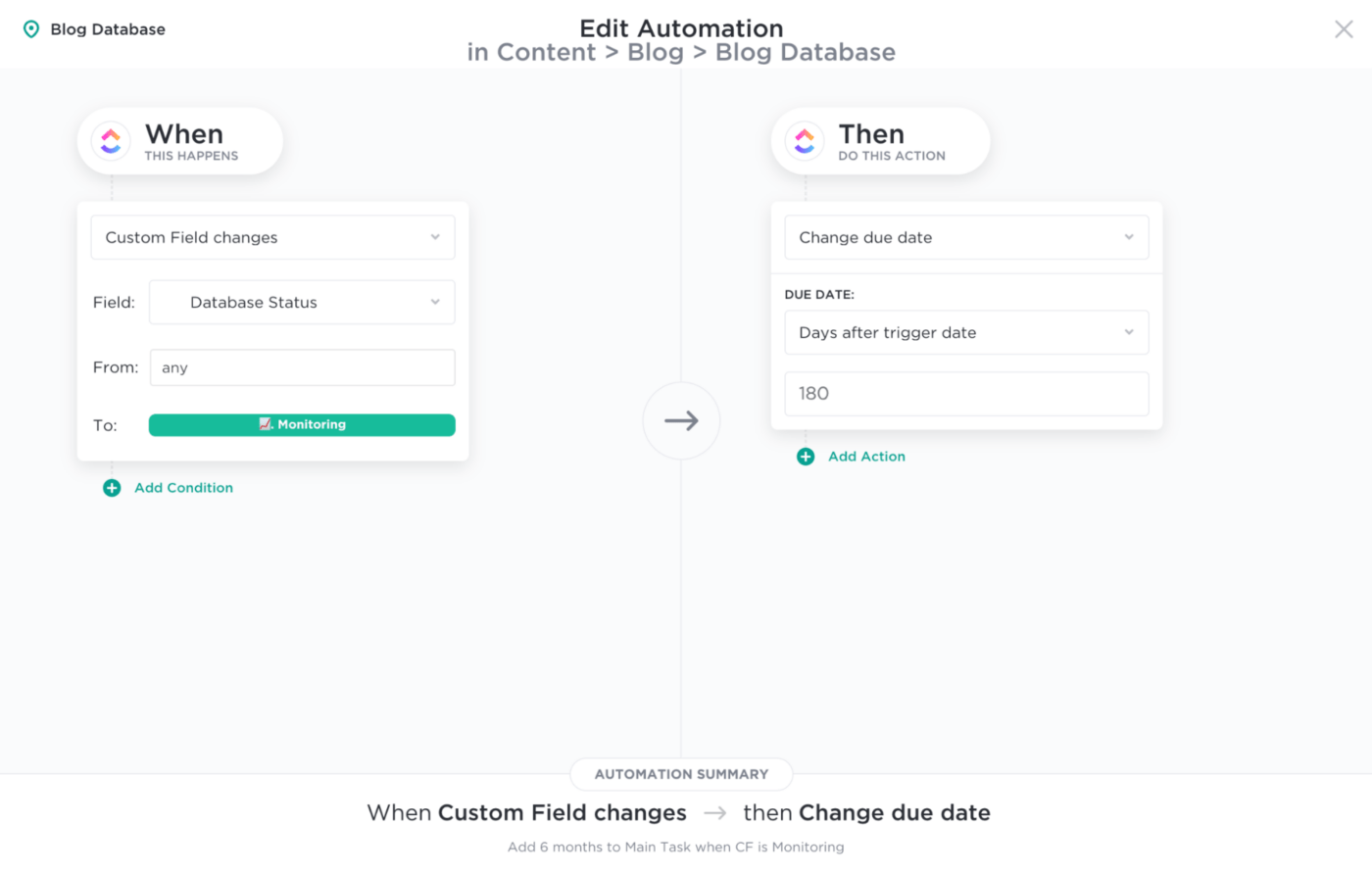
أنشئ عمليات أتمتة ClickUp المخصصة التي لا تحتوي على رموز في ثوانٍ.
تضمن أتمتة تاريخ الاستحقاق أن يتم تحليل أداء منشور المدونة في وقت ما في الأشهر الستة المقبلة.
يتم إعداد أتمتة أخرى لضمان تغيير الحقل المخصص لحالة قاعدة البيانات إلى تدقيق بعد انقضاء الأشهر الستة. يؤدي هذا بدوره إلى تشغيل أتمتة لإنشاء مهمة فرعية جديدة لتقييم الأداء، حيث يقوم فريق تحسين محركات البحث بتحليل أداء المدونة وتحديد ما إذا كانت هناك حاجة إلى تحديثات.
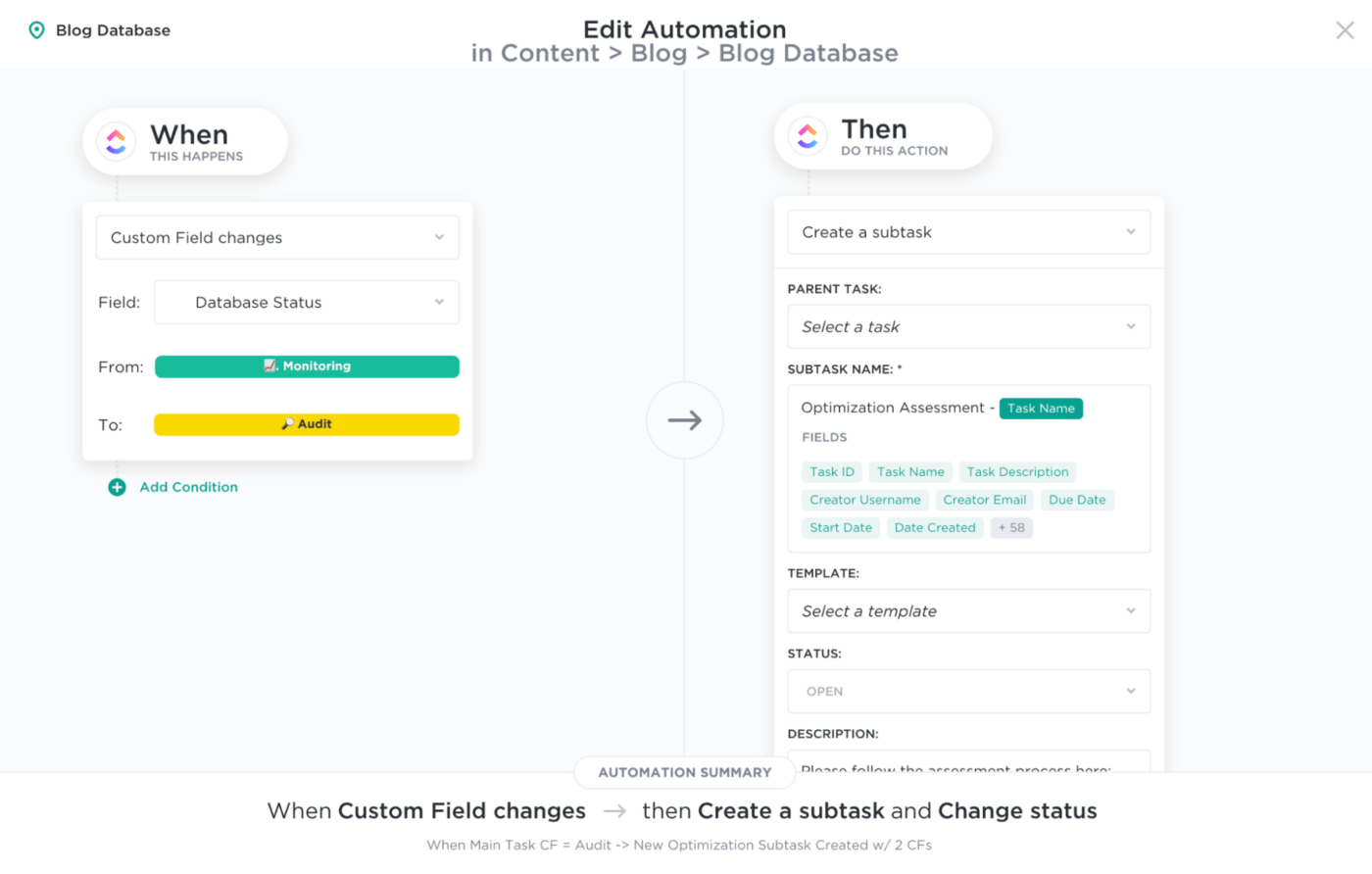
أتمتة حقل ClickUp المخصص لإنشاء المهام الفرعية
باختصار، يمكن أن تساعد الأتمتة في ضمان توحيد العمليات وعدم نسيان مهام سير العمل المطولة.
4. اجعل الأمر بسيطًا!
حاول أن تبقي كل شيء بسيطًا قدر الإمكان، من اصطلاحات التسمية إلى الأتمتة. هذا سيجعل العثور على الأشياء أسهل بما لا يقاس وسيجعل من الأسهل بكثير تعريف فريقك (وأي موظفين في المستقبل) بقاعدة البيانات وسير العمل الذي تشمله.
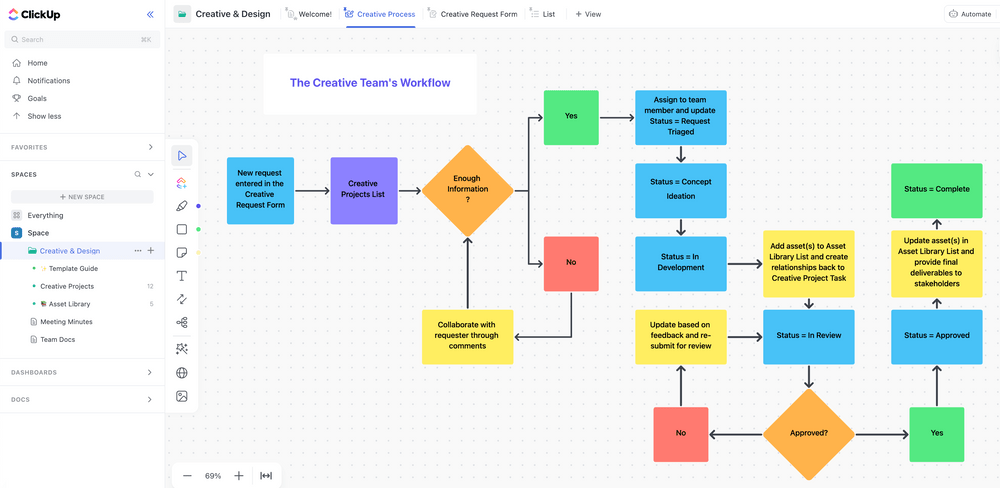
قم ببناء سير عمل كامل لفرق الإبداع والتصميم لديك باستخدام قالب ClickUp المفيد هذا
إذا كنت بحاجة إلى مساعدة في تبسيط سير عملك، فاستخدم قالب نموذج ClickUp للإبداع والتصميم لإنشاء تقسيم واضح لسير عمل التسويق الخاص بك. يدعم هذا القالب الجوانب التسويقية الشائعة مثل نماذج الاستلام، وطلبات ملخصات المحتوى، وإدارة مكتبات الأصول، بحيث يكون هناك مسار مباشر لكيفية عمل عملية تسويق المحتوى الخاص بك.
## ابدأ
قد يكون أصعب جزء في مشروع كهذا هو البدء. ففي نهاية المطاف، يعد إنشاء قاعدة بيانات للمحتوى مهمة ضخمة قد تؤدي إلى شلل في التحليل.
إذا كنت تنشئ قاعدة بياناتك من الصفر، سواءً باستخدام ClickUp أو أي أداة أخرى لإدارة المهام أو المشاريع، ابدأ بالتخطيط لقاعدة بياناتك باستخدام الخطوات الأساسية التي تمت مناقشتها في هذه المدونة :
- حدد ما تحتاج إلى تتبعه وكيف ستقوم بتتبعه
- تحديد كيفية تصنيف المحتوى الخاص بك
- حدّد التفاصيل (مثل التواريخ، أو المعينين، أو البيانات والتحليلات) التي تحتاج إلى تخزينها في قاعدة بياناتك
- تحديدسير عمل المحتوى الأساسي (مثل تحديثات المحتوى، وسحب حركة المرور ومعدل التحويل، وتحسين محركات البحث) التي ستحتاج إلى إدارتها في قاعدة البيانات. تأكد من إمكانية تهيئة قاعدة بياناتك لتتبع تدفقات العمل هذه.
نظرًا لأن تحديد وتتبع حتى هذه الخطوات الأولى يمكن أن يكون مرهقًا بعض الشيء، خاصةً إذا كنت تتعامل مع كمية كبيرة أو عدة أنواع من المحتوى، فحاول تنظيم أفكارك باستخدام الخرائط الذهنية في ClickUp .
سيسمح لك القيام بذلك بتحديد الخطوط العريضة لقاعدة بياناتك على مستوى عالٍ مع تصور كيفية ارتباط الأجزاء ببعضها البعض.

خريطة ذهنية لتصور العلاقات بين مهام مدونة ClickUp
يمكنك أيضًا استخدام المستندات في ClickUp لتخزين الملاحظات والتعاون في الوقت الفعلي مع فريقك بشأن بنية قاعدة البيانات وتنفيذها. يضمن ذلك أن يكون الجميع على نفس الصفحة ويجعل من السهل تفويض المسؤوليات عندما تكون مستعدًا لبدء البناء.

التعاون في الوقت الفعلي في مستندات ClickUp
للحصول على السبق في كل هذا التخطيط, تنزيل قاعدة بيانات مدونتنا المجانية وصفحة الهبوط قوالب قاعدة البيانات. هذه قوالب المحتوى تستند إلى قواعد بيانات مدونة فريق التسويق الخاص ب ClickUp وقواعد بيانات الصفحات المقصودة، لذا فقد تم تجربتها واختبارها.
نصيحة أخيرة يجب أخذها في الاعتبار عند تخطيط قاعدة بيانات المحتوى وإنشائها وصيانتها: أشرك فريقك بأكمله.
إشراك فريقك بأكمله منذ البداية يضمن لك ذلك:
- تضع في اعتبارك جميع الزوايا عند التخطيط
- تقوم بتقسيم العمل الشاق في البناء
- تشارك في أعمال صيانة قاعدة البيانات وتحديثها من الآن فصاعداً.
إذا كنت في حاجة إلى أداة تعاون رائعة تعمل أيضًا كأداة مثالية لقاعدة بيانات المحتوى، فلا تبحث عن كليك أب . ابدأ مع فريقك على خطتنا المجانية للأبد، واجمع تعاون فريقك وأدوات قواعد البيانات وإدارة العمل في مكان واحد.

